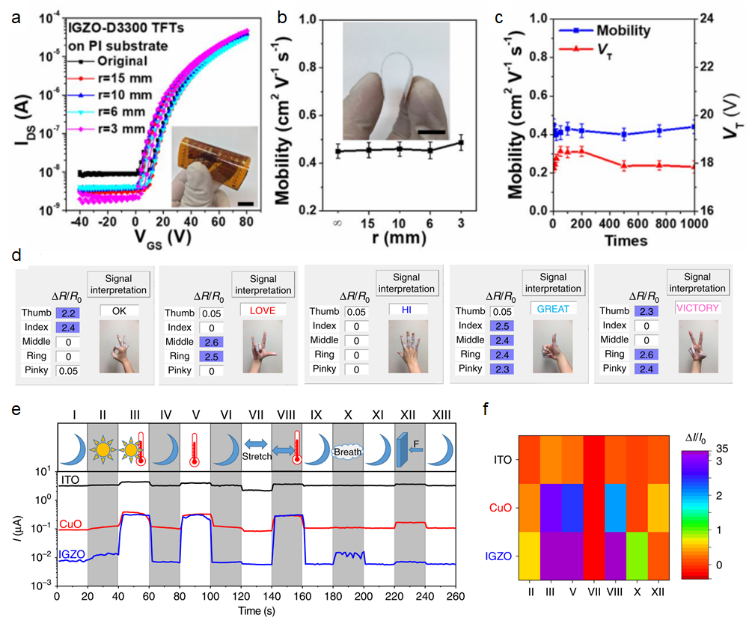17758013020 Chen Chen
-
-
-
17816169069 Jinglin Jian
-
17758013020 Chen Chen
17816169069 Jinglin Jian

Prof. Binghao Wang is currently a Professor at School of Electronic Science and Engineering, Southeast University. Prior to this, he was a Project Researcher at The University of Tokyo, and a Joint PhD student and Postdoctoral Researcher at Northwestern University. He obtained his B.E., M.S., and PhD from Soochow University. His research interests include flexible/stretchable and wearable organic/inorganic electronics. he has published 2 book chapters and more than 70 papers in Nat. Electron., Chem. Rev., PNAS, Nat. Comm., Sci. Adv., etc.
Semiconductor/Insulating Polymer Blends for Diverse Thin-Film Transistors and Sensors
Binghao Wang*
*School of Electronic Science & Engineering, Southeast University, Nanjing, Jiangsu 210096, China (binghaowang@seu.edu.cn)
Abstract
Compared to semiconductor devices prepared through vacuum methods, organic and metal oxide semiconductor thin films prepared via solution processing have significant cost and efficiency advantages. However, the device performance is lower compared to vacuum methods.[1] In the past decade, the use of semiconductor/insulator blends has been a common strategy to enhance device mobility and performance.[2] This report discusses the strategy of employing semiconductor/insulator hybrids and explores their applications in porous, photolithographic, and stretchable organic transistor circuits, as well as high-performance oxide semiconductor sensors.
Utilizing a naturally inspired breath-patterned method, organic polymer semiconductor/insulator films with nanoscale pores were prepared using spin-coating. The obtained thin-film transistor sensors exhibited high gas response sensitivity, and the electrochemical transistors demonstrated fast switching speeds and transconductance.[3]
Mixing organic polymer semiconductors with commercial photoresists, a self-formed vertical phase separation structure emerged during the film-forming process, thereby protecting the underlying organic polymer semiconductor. This achieved submicron-level photolithographic patterning in three simple steps.[4]
Stacking organic polymer semiconductor layers with stretchable insulator polymer structures ensured stable device performance under 50% elongation, demonstrating applications in stretchable logic circuits and light-detecting imaging.[5]
Combining metal salts with spinnable polymers, metal oxide semiconductor nanofiber films were mass-produced using electrospinning technology.[6] Furthermore, embedding them in insulating elastomers resulted in stretchable multifunctional sensors and arrays. These sensors can be used to measure and differentiate various external stimuli, including analytes, light, strain, pressure, temperature, humidity, body movements, and respiratory function.

Figure 1: (a) Transfer curves and (b-c) mechanical properties of top-gate flexible CBC/IGZO TFTs on a PI substrate. (d) Demonstration of an array of strain sensors placed on a hand to translate gestures. (e) Real-time simultaneous sensing of ambient solar light, temperature, stretching, exhaled gas, and pressure, with an integrated IGZO, CuO, and ITO e-skin. (d) Relative current change of IGZO, CuO, and ITO resistors under different stimuli.
References
1. B. H. Wang, W. Huang, L. F. Chi, M. Al-Hashimi, T. J. Marks and A. Facchetti, Chem Rev, 2018, 118, 5690-5754.
2. L. Janasz, M. Borkowski, P. W. M. Blom, T. Marszalek and W. Pisula, Adv. Funct. Mater., 2022, 32.
3. X. N. Zhang, B. H. Wang, L. Z. Huang, W. Huang, Z. Wang, W. G. Zhu, Y. Chen, Y. L. Mao, A. Facchetti and T. J. Marks, Sci. Adv., 2020, 6.
4. B. H. Wang, W. Huang, S. Lee, L. Z. Huang, Z. Wang, Y. Chen, Z. H. Chen, L. W. Feng, G. Wang, T. Yokota, T. Someya, T. J. Marks and A. Facchetti, Nat. Commun., 2021, 12.
5. H. Shim, K. Sim, B. H. Wang, Y. C. Zhang, S. Patel, S. Jang, T. J. Marks, A. Facchetti and C. J. Yu, Nat. Electron., 2023, 6, 349-359.
6. B. Wang, A. Thukral, Z. Xie, L. Liu, X. Zhang, W. Huang, X. Yu, C. Yu, T. J. Marks and A. Facchetti, Nat. Commun., 2020, 11, 2405.